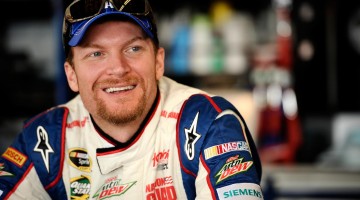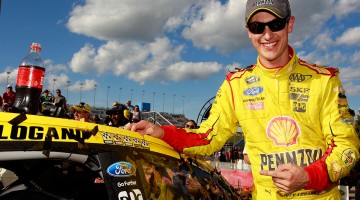:: This is part three in a series of four posts (to see all of the posts on one page, click here) ::
Me: Anyway, is it getting harder to get interviews with the drivers, to get time with them now that there’s so much attention?
Liz: Sure, yea, and I feel like everybody would tell you that.
Me: So how do you do it? Is it a matter of just being persistent and contacting the PR people?
Liz: Well, I can’t give you the date but over the last couple of years NASCAR kind of, I think, tried to preempt a lot of the requests for one-on-one interviews by organizing group sessions for everybody in the top 10. It’s probably a deal they worked out with the drivers, who I’m sure were getting tired of a million interview requests. So they convinced the drivers, if you’re in the top ten you must be available to the media every race for a twenty minute window, or whatever it is. And in a way I think that makes a lot of sense. It does kind of let them fulfill their obligation and probably takes care of 80% of the reporters needs.
So that I can see the wisdom of and then if you’re working on something special and you need a one-on-one these days you go to the PR person and sort of state your case. My impression is the decisions are made on how significant is your publication to them. I mean, I worked at USA Today and covered racing. People were very eager to talk to me at USA Today. I’ve worked at papers of all different sizes and I benefited even when I worked at the Charlotte Observer. I mean that’s a huge advantage in racing because that’s the paper of record, really. So, as a reporter I don’t like the reality that the decisions probably are based on your circulation size or influence or your hometown. I’m sure each driver is attentive to the paper in their market. That all makes sense, I have no gripe with that, but I guess the reality is simply that yes, there’s a crush of media covering this sport: print, way more broadcast than before and drivers are really tapped thin.
The days of riding to a race track in a pickup truck with Earnhardt are gone, I’m afraid. Every so often I’m sure somebody can pull that off and I still think it’s the stick and ball sport, or big league sport where that is possible. It is probably just a matter of persistence and making a case that you’re working on a story that really requires this kind of one-on-one time or this kind of access. I still feel they treat the request as fairly as any sport, if not more fairly, but it’s just tough.
Me: So in terms of that, what is the biggest change you’ve seen or changes that you’ve seen in how NASCAR is reported in the media over the years? I know it’s getting bigger, but is it getting better?
Liz: Well, that’s a really hard question and a really good question. I guess this, well it certainly isn’t really unique to NASCAR but it really strikes me, the whole notion of the 24 news cycle. So that is ESPN.com, NASCAR.com, the whole blogosphere, individual paper’s websites. But if say, Dale Jr.’s year of deciding whether to leave DEI or not, if that had happened ten years ago, ya know, there would have been one tenth the coverage or even a smaller percentage because you’d only write it once a day, not once every two hours. The poor guy and I think he was embarrassed. He was worried that fans were getting sick of him and sick of this whole issue, and he spoke about that, and I empathize. Every incremental twitch that Max Siegel made was on NASCAR.com or ESPN.com, and then it was responded to, and then it’s just this mountain of coverage. In a story like that I’m not sure if it’s better because it’s so redundant and incremental. But then again there’s an appetite for it. Websites are really good about responding to what fans care about, as are bloggers. So their barometer in a lot of way is more true than newspapers, they’re very connected to what people are talking about and arguing about and caring about. But it’s just the constant, constant unending stuff.



